Assess Yourself
How well do you understand the ideas in this lesson?
Goal:
Goal:
Are you ready to take this lesson's quiz? These questions will help you find out. Go back to the lesson if you do not know an answer.
1. Which number line shows:
23
-
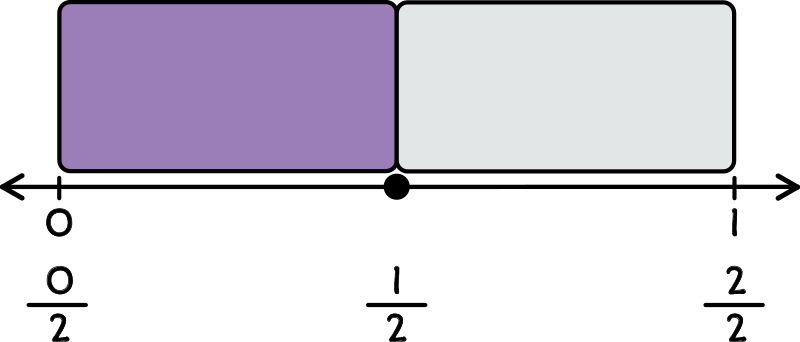
Rectangle partitioned into 2 equal parts. 1 parts are filled. Number line underneath from 0 to 1. Markers for each part. Markers are labeled 02, 12, 22.
-
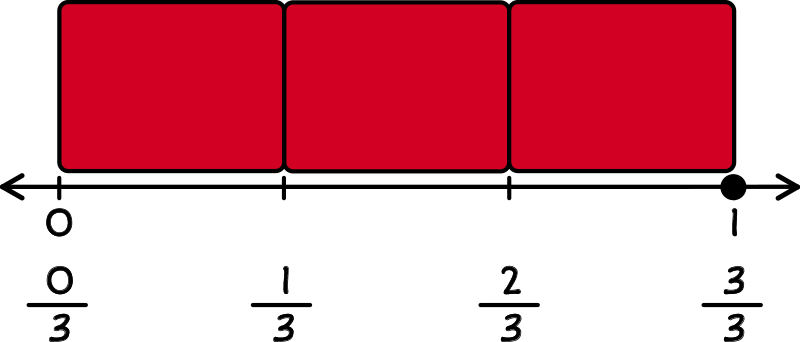
Rectangle partitioned into 3 equal parts. 3 parts are filled. Number line underneath from 0 to 1. Markers for each part. Markers are labeled 03, 13, 23, 33
-
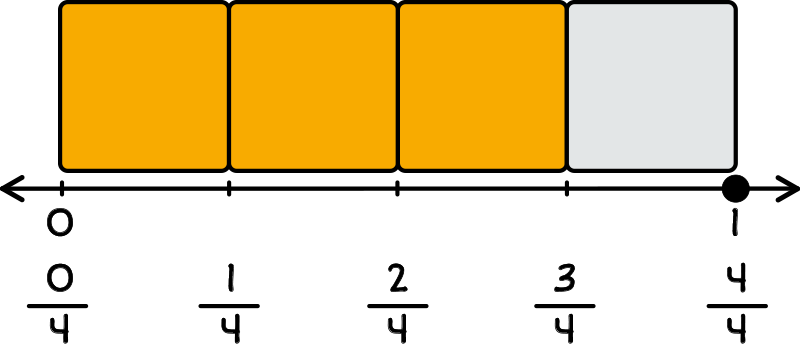
Rectangle partitioned into 4 equal parts. 3 parts are filled. Number line underneath from 0 to 1. Markers for each part. Markers are labeled 04, 14, 24, 34, 44
-
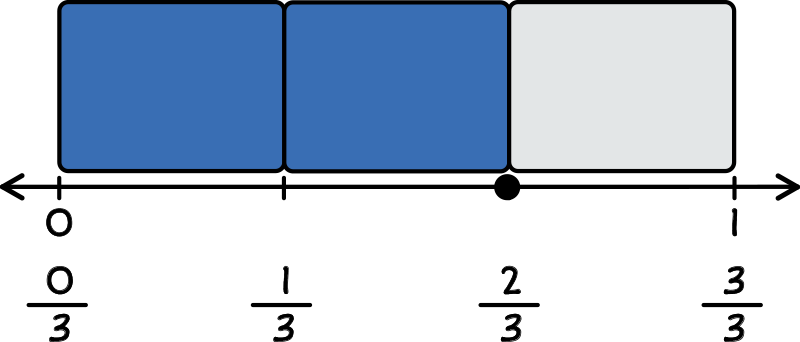
Rectangle partitioned into 3 equal parts. 2 parts are filled. Number line underneath from 0 to 1. Markers for each part. Markers are labeled 03, 13, 23, 33
Sorry, that is not correct. This number line shows 12.
Sorry, that is not correct. This number line shows 33.
Sorry, that is not correct. This number line shows 44.
Yes! This number line shows 23.
2. What fraction is recorded on this number line?
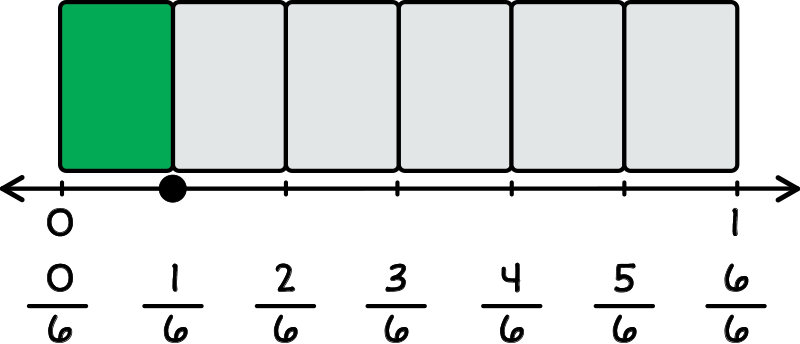
Rectangle partitioned into 6 equal parts. 1 part is filled in. Number line underneath with markers for each part. Markers are labeled 06, 16, 26, 36, 46, 56, 66. Dot above 16.
- 16
- 04
- 14
- 36
Yes! 16 has a dot above it on the number line.
Sorry, that is not correct. The recorded fraction has a dot above it on the number line.
Sorry, that is not correct. The recorded fraction has a dot above it on the number line.
Sorry, that is not correct. The recorded fraction has a dot above it on the number line.
3. Which number line shows part of a whole?
-
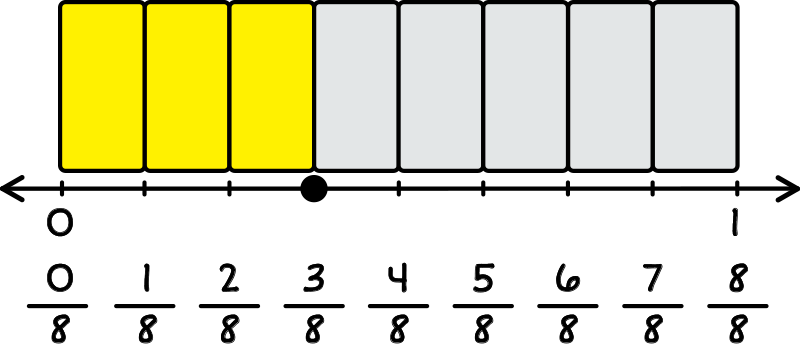
Rectangle partitioned into 8 parts. 3 parts are filled in. Number line underneath from 0 to 1 with markers for each part. Markers are labeled 08, 18, 28, 38, 48, 58, 68, 78, 88. Dot above 38.
-
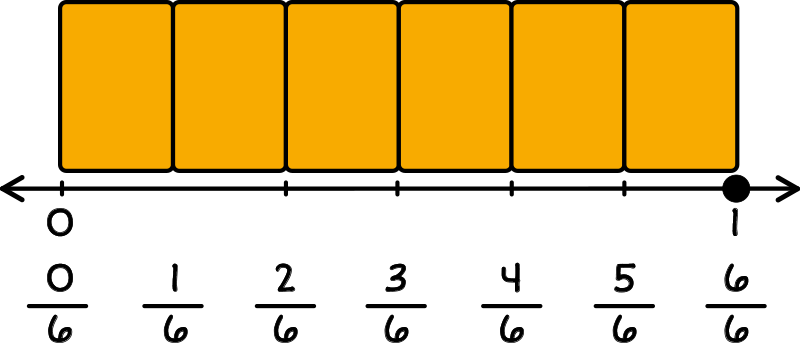
Rectangle partitioned into 6 parts. 6 parts are filled in. Number line underneath from 0 to 1 with markers for each part. Markers are labeled 06, 16, 26, 36, 46, 56, 66. Dot above 66.
-
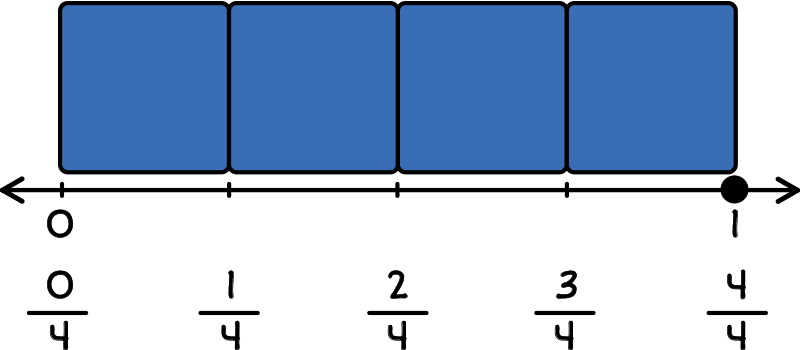
Rectangle partitioned into 4 parts. 4 parts are filled in. Number line underneath from 0 to 1 with markers for each part. Markers are labeled 04, 14, 24, 34, 44. Dot above 44.
-
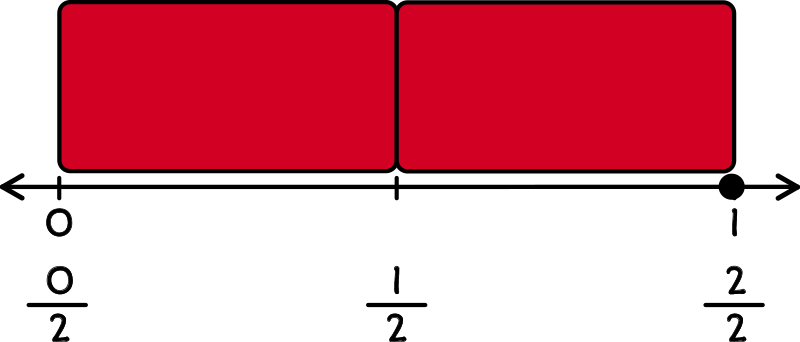
Rectangle partitioned into 2 parts. 2 parts are filled in. Number line underneath from 0 to 1 with markers for each part. Markers are labeled 02, 12, 22. Dot above 22.
Correct! This number line is partitioned into 8 equal parts, and 3 parts are colored in.
Sorry, that is not correct. This number line shows a whole because all of the parts are colored in.
Sorry, that is not correct. This number line shows a whole because all of the parts are colored in.
Sorry, that is not correct. This number line shows a whole because all of the parts are colored in.
4. Which number line shows a whole?
-
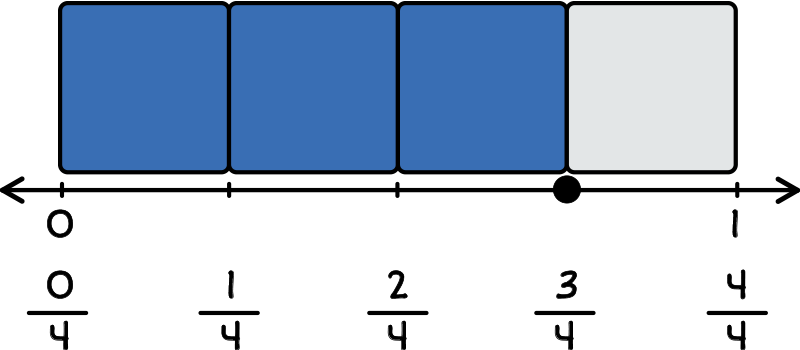
Rectangle partitioned into 4 parts. 3 parts are filled. Number line underneath from 0 to 1 with a marker for each parts. Markers are labeled 04, { \frac{1}{4} }\), { \frac{2}{4} }\), { \frac{3}{4} }\), { \frac{4}{4} }\). Dot above 34.
-
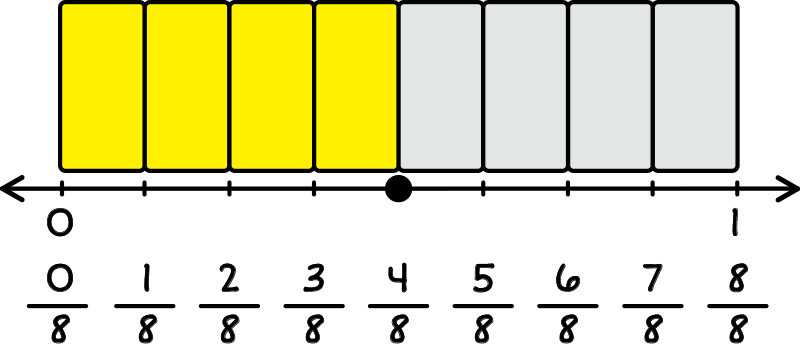
Rectangle partitioned into 8 parts. 4 parts are filled. Number line underneath from 0 to 1 with a marker for each parts. Markers are labeled 08, { \frac{1}{8} }\), { \frac{2}{8} }\), { \frac{3}{8} }\), { \frac{4}{8} }\), { \frac{5}{8} }\), { \frac{6}{8} }\), { \frac{7}{8} }\), { \frac{8}{8} }\). Dot above 48.
-
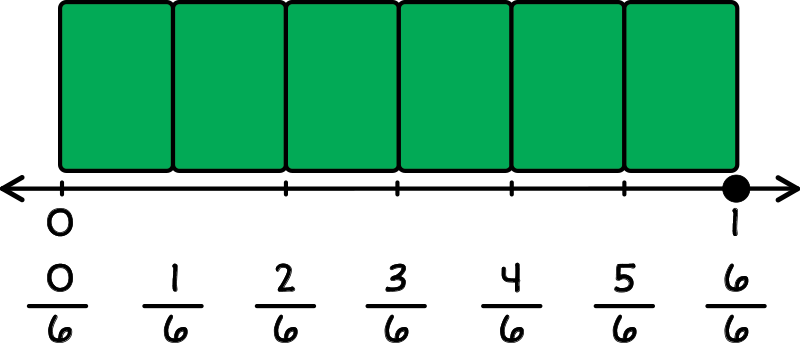
Rectangle partitioned into 6 parts. 6 parts are filled. Number line underneath from 0 to 1 with a marker for each parts. Markers are labeled 06, { \frac{1}{6} }\), { \frac{2}{6} }\), { \frac{3}{6} }\), { \frac{4}{6} }\), { \frac{5}{6} }\), { \frac{6}{6} }\). Dot above 66.
-
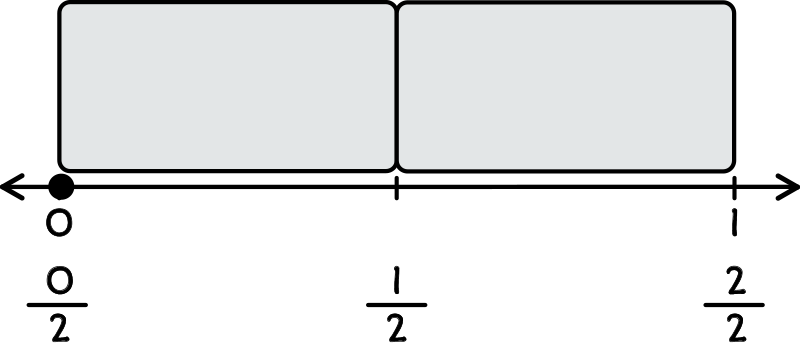
Rectangle partitioned into 2 parts. 0 parts are filled. Number line underneath from 0 to 1 with a marker for each parts. Markers are labeled 02, { \frac{1}{2} }\), { \frac{2}{2} }\). Dot above 02.
Sorry, that is not correct. This number line shows part of a whole because only some of the parts are colored in.
Sorry, that is not correct. This number line shows part of a whole because only some of the parts are colored in.
Yes! This number line shows a whole because all of the parts are colored in.
Sorry, that is not correct. This number line shows no parts of a whole because none of the parts are colored in.
5. How many parts should a number line be partitioned into if it is recording 14?
- 1
- 6
- 3
- 4
Sorry, that is not correct. The denominator is 4, so the number line should be partitioned into 4 equal parts.
Sorry, that is not correct. The denominator is 4, so the number line should be partitioned into 4 equal parts.
Sorry, that is not correct. The denominator is 4, so the number line should be partitioned into 4 equal parts.
Yes! The denominator is 4, so the number line should be partitioned into 4 equal parts.
6. Which number line shows:
03
-

Rectangle partitioned into 6 equal parts. 1 parts are filled. Number line underneath from 0 to 1 with markers for each part. Markers are labeled 06, 16, 26, 36, 46, 56, 66. Dot above 16.
-
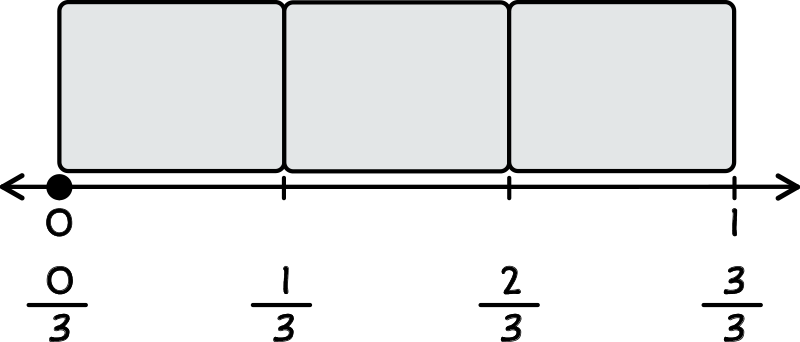
Rectangle partitioned into 3 equal parts. 0 parts are filled. Number line underneath from 0 to 1 with markers for each part. Markers are labeled 03, 13, 23, 33. Dot above 03.
-
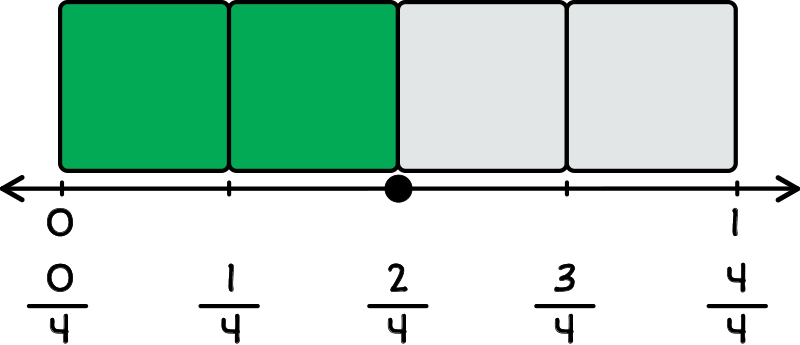
Rectangle partitioned into 4 equal parts. 2 parts are filled. Number line underneath from 0 to 1 with markers for each part. Markers are labeled 04, 14, 24, 34, 44. Dot above 24.
-
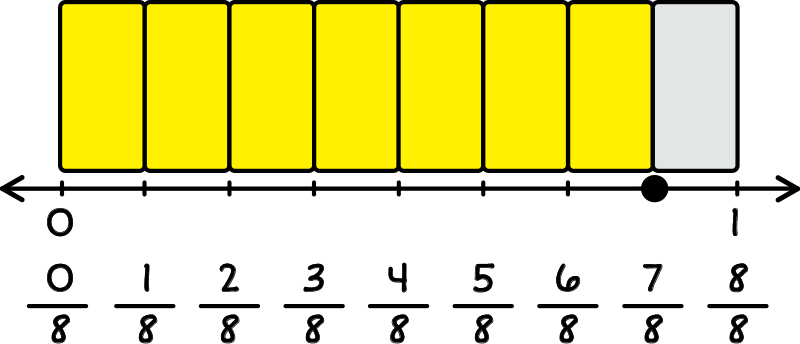
Rectangle partitioned into 8 equal parts. 7 parts are filled. Number line underneath from 0 to 1 with markers for each part. Markers are labeled 08, 18, 28, 38, 48, 58, 68, 78, 88. Dot above 78.
Sorry, that is not correct. This number line shows 16.
Yes! This number line shows 03.
Sorry, that is not correct. This number line shows 24.
Sorry, that is not correct. This number line shows 78.
7. What fraction is recorded on this number line?

Rectangle partitioned into 4 equal parts. 3 parts are filled in. Number line underneath from 0 to 1 and markers for each part. Parts are labeled 04, 14, 24, 34, 44. Dot above 34.
- 44
- 34
- 26
- 88
Sorry, that is not correct. The recorded fraction has a dot above it on the number line.
Yes! 34 has a dot above it on the number line.
Sorry, that is not correct. The recorded fraction has a dot above it on the number line.
Sorry, that is not correct. The recorded fraction has a dot above it on the number line.
8. Which number line shows part of a whole?
-
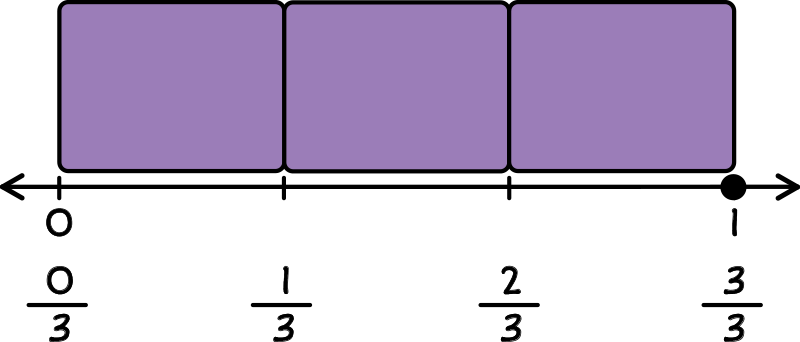
Rectangle partitioned into 3 parts. 3 parts are filled. Number line underneath from 0 to 1 with markers for each parts. Markers are labeled 03, { \frac{1}{3} }\), { \frac{2}{3} }\), { \frac{3}{3} }\). Dot above 33.
-
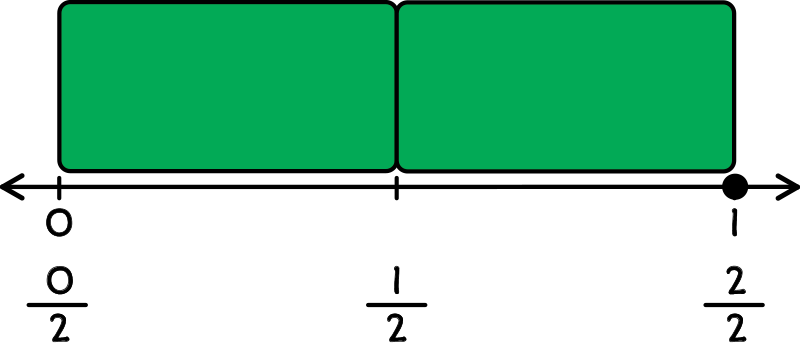
Rectangle partitioned into 2 parts. 2 parts are filled. Number line underneath from 0 to 1 with markers for each parts. Markers are labeled 02, { \frac{1}{2} }\), { \frac{2}{2} }\). Dot above 22.
-
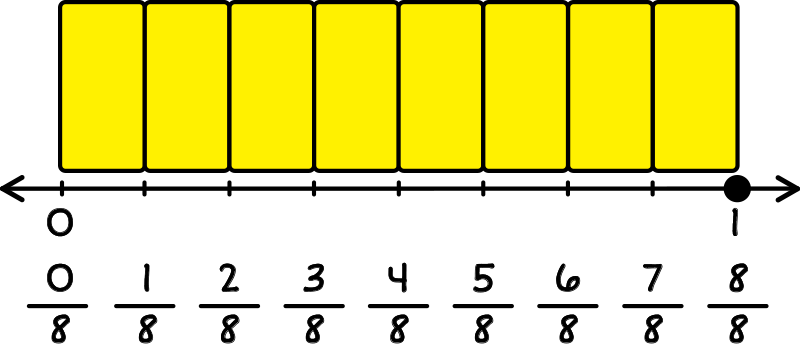
Rectangle partitioned into 8 parts. 8 parts are filled. Number line underneath from 0 to 1 with markers for each parts. Markers are labeled 08, { \frac{1}{8} }\), { \frac{2}{8} }\), { \frac{3}{8} }\), { \frac{4}{8} }\), { \frac{5}{8} }\), { \frac{6}{8} }\), { \frac{7}{8} }\), { \frac{8}{8} }\). Dot above 88.
-
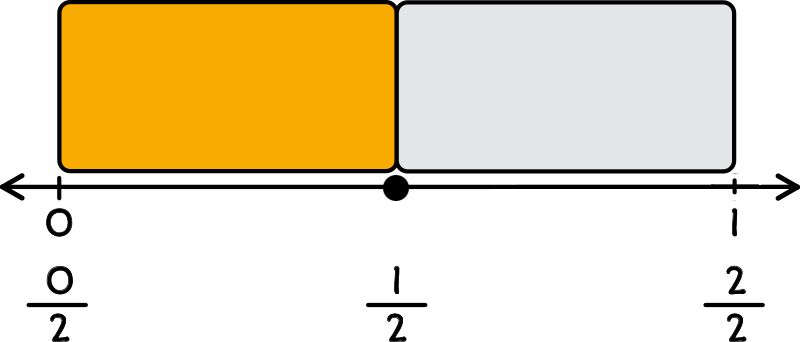
Rectangle partitioned into 2 parts. 1 parts are filled. Number line underneath from 0 to 1 with markers for each parts. Markers are labeled 02, 12, 22. Dot above 12.
Sorry, that is not correct. This number line shows a whole because all of the parts are colored in.
Sorry, that is not correct. This number line shows a whole because all of the parts are colored in.
Sorry, that is not correct. This number line shows a whole because all of the parts are colored in.
Correct! This number line is partitioned into 2 equal parts, and 1 part is colored in.
9. Which number line shows a whole?
-
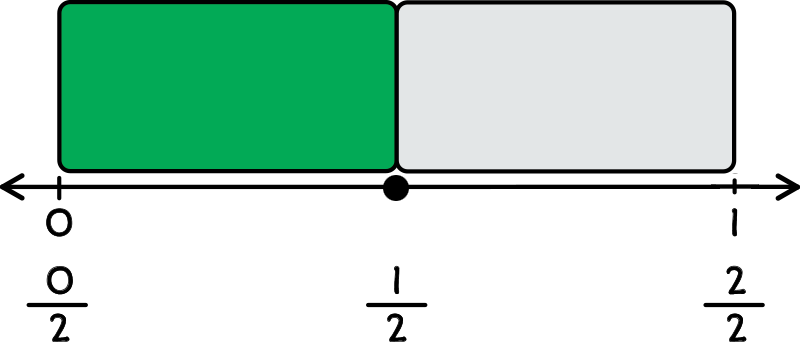
Rectangle partitioned into 2 parts. 1 parts are filled in. Number line underneath from 0 to 1 with markers for each part. Markers are labeled 02, 12, 22. Dot above 12.
-

Rectangle partitioned into 4 parts. 2 parts are filled in. Number line underneath from 0 to 1 with markers for each part. Markers are labeled 04, 14, 24, 34, 44. Dot above 24.
-
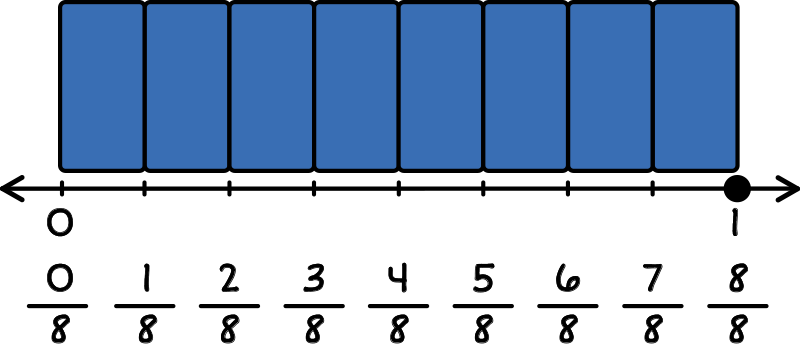
Rectangle partitioned into 8 parts. 8 parts are filled in. Number line underneath from 0 to 1 with markers for each part. Markers are labeled 08, 18, 28, 38, 48, 58, 68, 78, 88. Dot above 88.
-
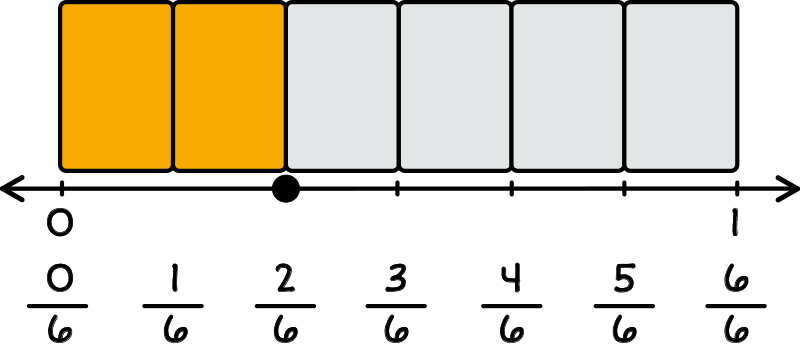
Rectangle partitioned into 6 parts. 2 parts are filled in. Number line underneath from 0 to 1 with markers for each part. Markers are labeled 06, 16, 26, 36, 46, 56, 66. Dot above 26.
Sorry, that is not correct. This number line shows part of a whole because only some of the parts are colored in.
Sorry, that is not correct. This number line shows part of a whole because only some of the parts are colored in.
Yes! This number line shows a whole because all of the parts are colored in.
Sorry, that is not correct. This number line shows part of a whole because only some of the parts are colored in.
10. How many parts should a number line be partitioned into if it is recording 18?
- 8
- 1
- 4
- 6
Yes! The denominator is 8, so the number line should be partitioned into 8 equal parts.
Sorry, that is not correct. The denominator is 8, so the number line should be partitioned into 8 equal parts.
Sorry, that is not correct. The denominator is 8, so the number line should be partitioned into 8 equal parts.
Sorry, that is not correct. The denominator is 8, so the number line should be partitioned into 8 equal parts.
Summary
Questions answered correctly:
Questions answered incorrectly:
